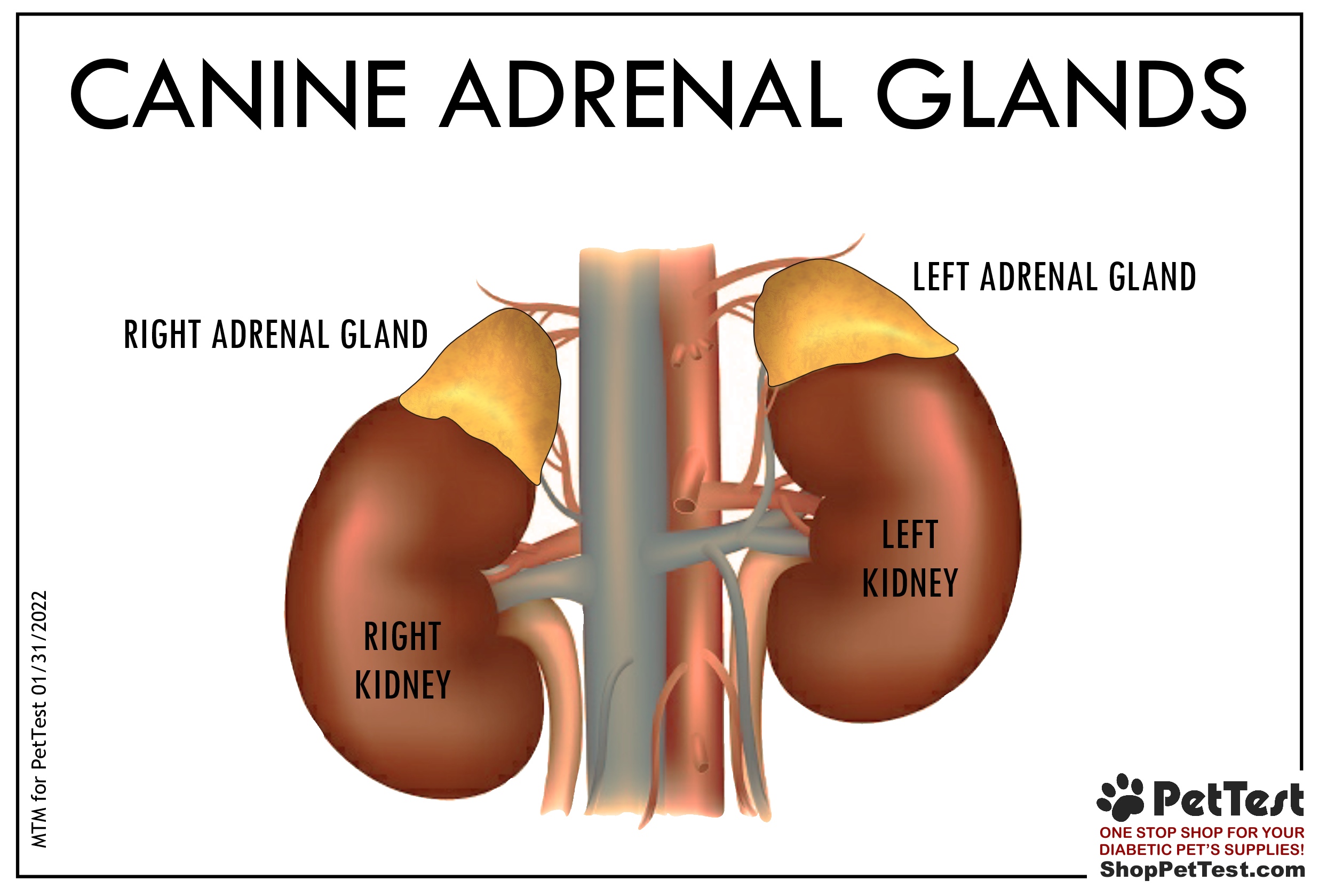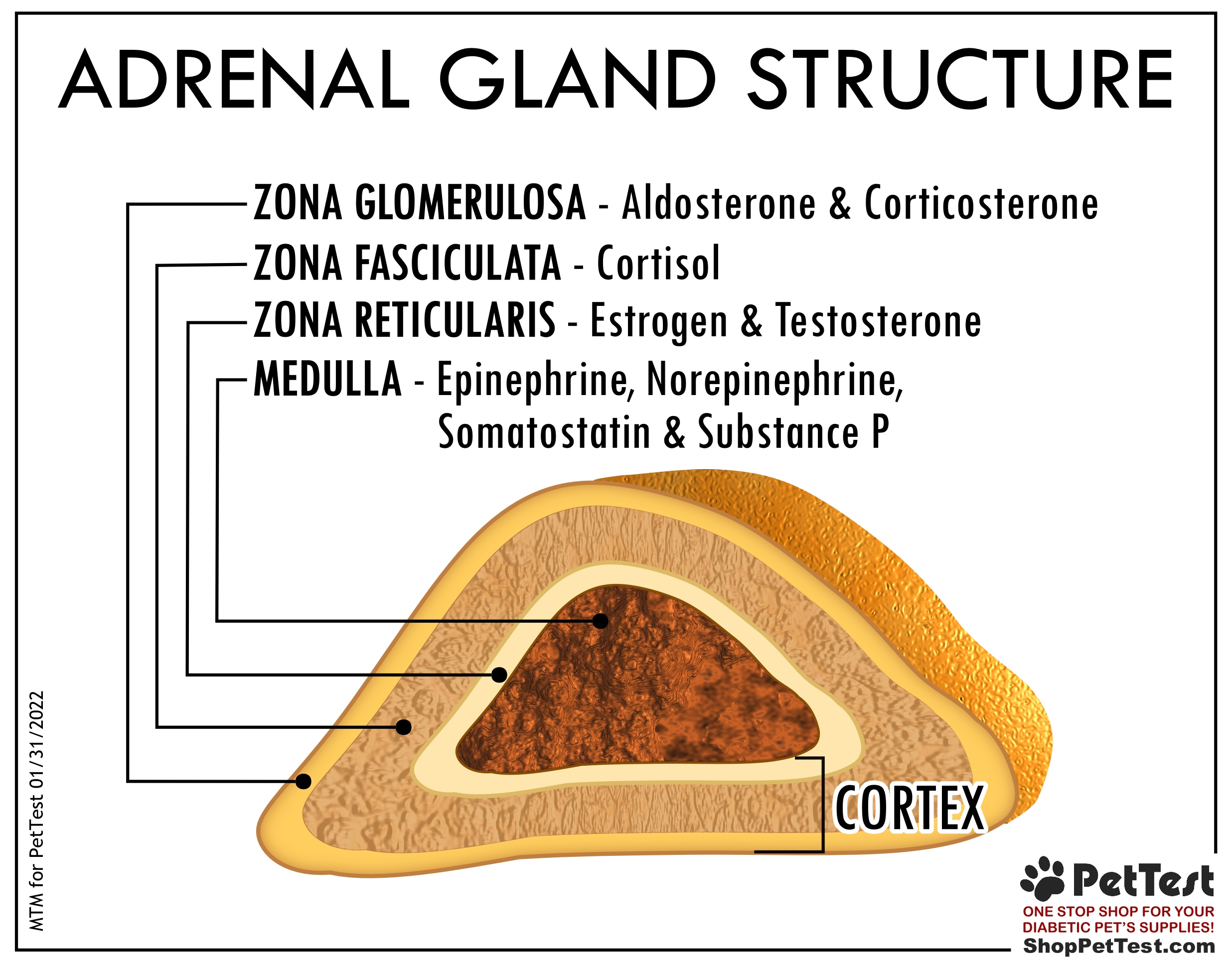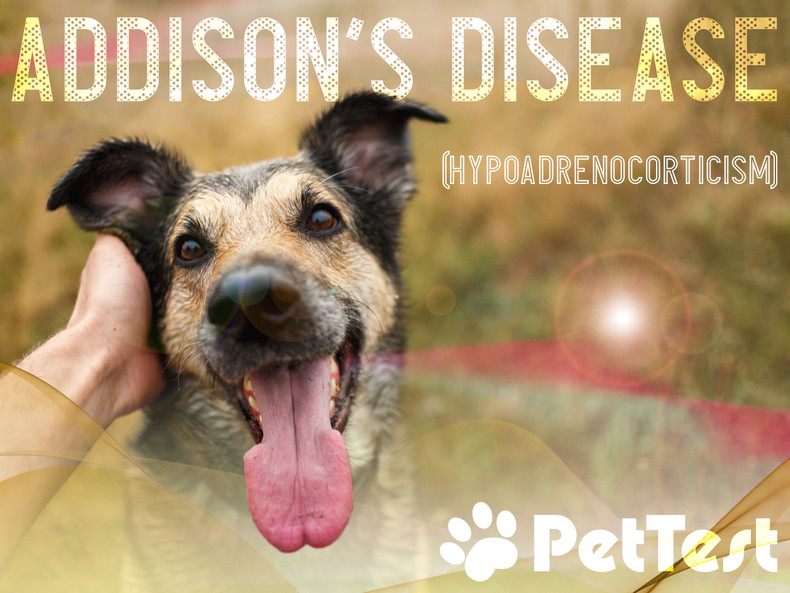Addison’s Disease (Hypoadrenocorticism)
Your dog has the following symptoms: lethargy, excessive drinking and urinating, weight loss, lack of appetite and hind end weakness. Being well versed in canine diabetes I would automatically think diabetes, uncontrolled blood glucose levels and possibly diabetic ketoacidosis. But did you know that Addison’s Disease can mimic other diseases and can be misdiagnosed? In fact, Addison’s Disease mimics so many other diseases that it is called “The Great Pretender.” Today I want to go over Addison’s Disease (hypoandrenocorticism), followed up with an interview from Helen Pietrzak, a member in our Facebook group Diabetic Dog Owners who has a dog, Rachel with Addison’s Disease.
Let’s dive right into what Addison’s Disease is and how to treat it, grab a cup of your favorite caffeinated beverage!
Adrenal glands are located right on top of the kidneys and the hormones they secrete are essential to the body and crucial for existence.

- Glucocorticoids – cortisol produced in the zona fasciculata activates the body’s antistress response, anti-inflammatory response and stimulates gluconeogenesis, helps regulate blood pressure and cardiovascular function.
- Mineralocorticoids – aldosterone and corticosterone control electrolyte balance and fluid balance. These are produced in the zona glomerulosa.
- Androgens – estrogen and testosterone are sex hormones produced in the zona reticularis.
- Catecholamines – epinephrine and norepinephrine (also known as adrenaline) control the fight or flight response are produced in the adrenal medulla.
- Peptides – also produced in the adrenal medulla, somatostatin inhibits secretion of hormones and substance P regulates mineralocorticoids.

What is Addison’s Disease?
When a dog is diagnosed with Addison’s disease the adrenal glands no longer produce cortisol and/or mineralocorticoids. These hormones are crucial for the body to survive, without these hormones’ survival is not possible. There are two types of Addison’s Disease: atypical and typical Addison’s.
- Atypical Addison’s happens when the adrenal glands no longer produce cortisol.
- Typical Addison’s – the adrenal glands no longer produce cortisol or aldosterone.
What breeds are genetically predisposed to Addison’s Disease?
Any breed can become Addisonian, but these breeds are predisposed: Standard Poodles Portuguese Water Dogs, West Highland Terriers, Great Danes, Labs, Pomeranians and German Shorthair Pointers. Vets are starting to see a higher incidence of Addison’s Disease in Goldendoodles and Labradoodles.
What are symptoms of Addison’s Disease?
- Lethargy
- Lack of appetite
- Weight loss
- Vomiting
- Diarrhea
- Dehydration
- Exercise intolerance
- Collapse
- Polydipsia
- Polyuria
- Tremors/shaking
- Low heart rate
- Hind end weakness
- Coat changes
Dogs with Addison’s Disease may not be diagnosed until they go into Addison’s crisis, this is fatal if the dog is not treated immediately.
As you can see by all the symptoms, Addison’s Disease can mimic other diseases like diabetes mellitus, diabetic ketoacidosis and kidney disease. This is why Addison’s Disease is appropriately nicknamed “The Great Pretender.”
How is Addison’s Disease diagnosed?
ACTH stimulation test along with a blood panel will diagnose Addison’s Disease. Other tests that a vet may want to run are basal cortisol levels, natural plasma ACTH, x-rays, ECG and ultrasound.
What medications are given for Addison’s Disease?
For Atypical Addison’s Disease a daily corticosteroid like prednisone is given.
For typical Addison’s Disease daily corticosteroid is given along with injections every three to four weeks of either Percoten or Zycortal. These medications are replacement therapy for aldosterone. Alternately there is a daily medication that can be given called Florinef. This medication has both the corticosteroid and mineralocorticoid.
What is the lifespan of a dog with Addison’s Disease?
Good news is an Addisonian dog can live a happy, long and normal life after diagnosis and proper treatment!
Helen and Rachel’s Story
Many of you may recognize Helen from our Facebook group, Diabetic Dog Owner’s because she has a diabetic dog, Puff. She also has a Standard Poodle, Rachel who is an Addisonian dog. I asked her several questions about Rachel and Addison’s Disease, here is our interview.
MM: How old was Rachel when she was diagnosed with Addison’s Disease?
HP: Rachel was five years old at diagnosis.
MM: Did Rachel have any other health issues or diseases before she was diagnosed with Addison’s Disease?
HP: Rachel was a very healthy Standard Poodle prior to Addison’s Disease with no other conditions.
MM: What symptoms led you to make a vet appointment for Rachel?
HP: Rachel started just being lethargic which was totally out of character for her, had lack of appetite, tremors, rear leg weakness which progressed to vomiting and diarrhea and then bloody diarrhea. We rushed her immediately to the vet who did a battery of tests as well as the ACTH stimulation test which showed Atypical Addison’s, other testing showed Hemorrhagic Gastroenteritis (HGE) and pancreatitis. She spent the day at the vet on IV and injectable Cerenia, came home for the night then went into the specialty vet the next day where she was run through another battery of tests confirming the above diagnosis’s as well as Megaesophagus (ME). My baby was a very sick girl.
MM: What medications does she have to take?
HP: Rachel is well managed on low dose protocol of 1mg prednisone each am as well as supplements for eyes, heart, Omega-3 fatty acids and B12.
MM: How long after medications were started did Rachel feel better?
HP: I started seeing improvement within two weeks, but it was at least three months before I saw the old playful Rachel. It took at least six months using specialty shampoo for her hair (poodles have hair like ours not fur) to start looking healthy again.
MM: Does Rachel require a special diet?
HP: Rachel eats a low-fat diet with a few store-bought treats, she can eat limited beef lung and mostly enjoys raw carrots or green beans with her little brother.
MM: What is protocol when you know that Rachel is going to be stresses (e.g., vet appointments)?
HP: When I know there is going to be a super stressful event like fireworks I give Trazadone and occasionally a 0.5 increase in her pred. I make sure the tv is louder, she has her Thundershirt on and I’m cuddling her.
MM: How often does Rachel need to go in for testing and what is the average cost?
HP: With Rachel being five years post diagnosis (Jan 24, 2017), we do her electrolytes about every six months or so unless there are other concerning symptoms with cost being around $150 with insurance.
MM: Does Rachel live a happy and normal life with Addison’s Disease?
HP: Rachel is a happy, playful and normal 10-year-old Poodle who runs around playing in the backyard with her four-year-old Standard Poodle sister or other poodle visitors. She acts like a puppy most of the time and if I didn’t tell you then you would never know she was Addisonian.

Thanks so much to Helen for a great insight into having a dog with Addison’s Disease!
Until next week stay comfy and caffeinated!
If you have any questions, comments or suggestions, please start a conversation below.
If you are looking for a Facebook community to join for support, I have proudly been an admin in Diabetic Dog Owners for over five years. You can also join Canine Diabetes Support and Information on Facebook as well.
Be sure to join the PetTest family on Facebook and Instagram. PetTest has fun, interactive posts AND they have fabulous giveaways every week!
Do you need a blood glucose meter kit for your diabetes arsenal? Click here to purchase one today!
For a printable version of this blog click here.

